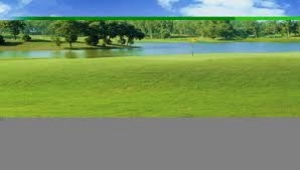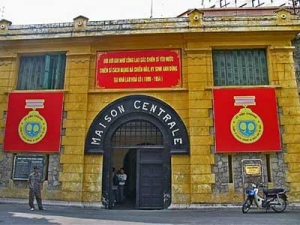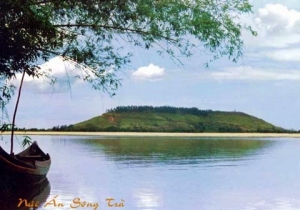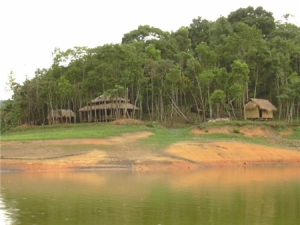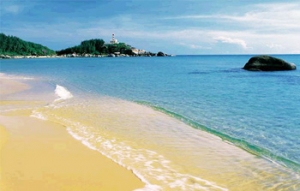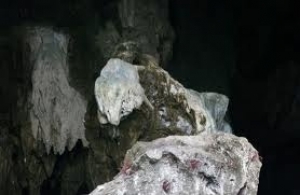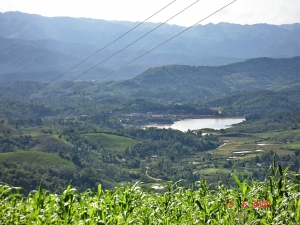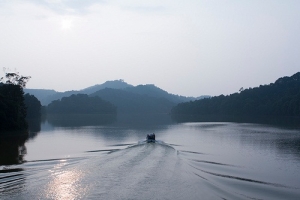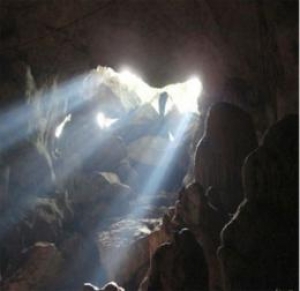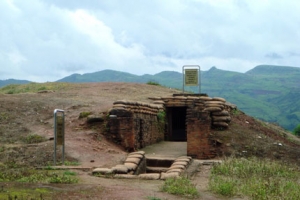
Asia Pacific Travel Team
Dong Mo tourist attraction
Dong Mo Resort
Atthe foot of Ba Vi Mountain in Son Dong Commune, Son Tay Town, with atotal area of 1,300ha, Dong Mo Resort is an ideal site for camping,Sunday picnics, or vacations. Dong Mo Lake has long supplied water forthe whole Son Tay area. More than 20 islands emerge from the lake.There is an international 36-hole golf course in King Island. Prettyvillas partially hidden in the woods mirrored in the transparent waterof the lake. Easily reached from Hanoi, Dong Mo Resort is an idealplace to escape from town and relax in a slow – paced environment.
Kings' Island Golf
TheGolf Course is covered with velvety, verdant grass, and has 18 holes ofinternational standard. The club is located along the shores of Dong MoLake. Accessing to the course is by boat. Opened in 1993, the 18-hole Lakeside course has numerous and varied uses of the water surrounding the course andthe gently sloping terrain. Water is in play on 13 of the 18 holes.Nature herself has created a superb setting for this very challenging6,454 yards in length and par 72. Mountain View course was opened in 2004. The course is designed to fit the setting’s naturalcontours. The design takes maximum advantage of the ambience of thewaterside setting, distant mountains and surrounding trees. The layoutof the golf course will excite and challenge all levels of players.Kings' Island Golf Club is an enjoyable challenge for golfers of alllevels.Kings'Island is the first 36-hole facility in northern Vietnam, including anair-conditioned clubhouse and restaurant, driving range, pro-shop,putting greens and sand bunker. It also has a clubhouse, swimming pool,tennis courts, sauna, guest villas, and boat dock.
Oncevisiting Dong Mo, you will find that the attraction presents a friendlychallenge, players will agree that they are truly among the finestgreens in Vietnam.
Hoa Lo Prison

Mostof the original prison was demolished in 1996 to make way for the HanoiTowers (now Somerset Grand Hanoi) serviced apartment and officecomplex, but the southernmost corner has been preserved and reopened tothe public as a memorial to the revolutionaries who died here inatrocious conditions. Visitors can view the original cells, completewith leg-irons, along with a selection of bilingual (Vietnamese andEnglish) displays illustrating the horrors of life in the prison duringthe French colonial period.
Conditionswere appalling; food was watery soup and bread. Prisoners werevariously isolated, starved, beaten, tortured for countless hours andparaded in anti-American propaganda. "It is easy to die but hard tolive," a prison guard told one new arrival, "and we will show you justhow hard it is to live." The prison is really “A Hell on Earth”.
The Hanoi Hilton was depicted in the eponymous 1987 Hollywood movie TheHanoi Hilton. Hanoi Tower, built on the site of the infamous prison"Hanoi Hilton"; the entrance to the remaining parts of the prisonvisible in the foreground. By 1996, most of the walls of the HanoiHilton had been torn down to make way for new construction. Portions ofthe walls were retained for historical reasons. The Vietnamese alsohave bitter memories of the prison, for many communist revolutionarieswere kept and tortured there. In 1998, the old front of the prison waspainted and restored and the remaining portions of the prison wereturned into a tourist site. Some of the cells have been opened andconsiderable information about Vietnamese prisoners is available. Theinformation about the U.S. prisoners of war is unreliable. There is nowa Hilton Hotel in Hanoi, called the Hilton Hanoi Opera Hotel, whichopened in 1999. It was built decades after the Vietnam War was over,but Hilton carefully avoided reusing the dreaded name Hanoi Hilton.
HoaLo Prison is a historical attraction to many local and foreignvisitors. You should pay a visit to the prison to experience thehistory with your own eyes.
Thien An Mountain,one of the famous beauty spots of Vietnam
Lying on the left bank of Tra Khuc river, east of the Quang Ngai's city, Thien An Mountain is one of the famous beauty spots which was ranked among Vietnam famed mountains since the reign of Nguyen Dynasty (1850).


Travel to Pa Khoang Reservoir in Dien Bien
Pa Khoang Reservoir is located in Muong Phang Commune, Dien Bien District, 20km from the Dien Bien City. Initially, Pa Khoang was just a stream. However, when irrigation works were built, the stream became a lovely lake with a system of drainage and watertight gates used to regulate the water running onto the thousands of hectares of rice fields.
Featured Sa Huynh Sea
Not only being a famous archaeological place of Vietname and the world with vestiges and antiquities of the ancient Champa culture, Sa Huynh sea is also a wonderful sea in the Centre region of Vietnam.
Sa Huynh sea is located in Duc Pho district which is 60 kilometers southern far away from Quang Ngai centre, closely besides 1A natural highway. Different from other seas having white sand, Sa Huynh sea has the shiny yellow sand which is more brilliant and sparkling under the sunlight. Because of its special sand, the sea was originally named Sa Hoang (yellow sand) , but this name was nearly the same with the name of Nguyen Hoang king of Nguyen So empire so people made a change of this name to Sa Huynh.
Sa Huynh beach looks like crescent moon which is 5-6 kms in length. Seeing through the sea water, the sea floor contains sloping yellow sands which are very smooth. Having the rock attractions such as Chau Me, Monkey island, etc and peaceful resorts in pure air, the sea becomes a safe and attractive travel destination for visitors.
Travel to Sa Huynh sea, visitor have chances to see the historical railway located at km 985 near the train station which was built to exploit salt by the French colonists.

Salt exploitation
Visitors can also contemplate a series of jar tombs and ancient artifacts buried in the ground, the remains of featured Champa culture which was discovered by French archaeologists in “Sa Huynh culture” work in the beginning of XX century.

Jar tombs of Champa culture
Cau gai and Huynh de crab are two most famous dishes of Sa Huynh sea. Huynh de crab is a special kind of crab which is very big, red-brick and weighs up to 1 kilogram each one. The crab spoiled then served with chili salt is a delicious and unforgettable dish.

Huynh de crab spoiled and served with chili salt
Moreover, salted nhum is another pride of Sa Huynh residents. Nhum, also known as cau gai, is one kind of sea animals, is found depending on reasons and the local people make them salted for using all year. Being famous through the country , salted nhum formerly was a special dish to tribute to the king.
Small and wild fishing village Sa Huynh now becomes a beautiful town attracting more and more visitors. They comes to contemplate the peaceful beauty of ancient culture which remains on the faces , the warmly close lifestyle of the local residents ; the ancient pottery products and the household items made by local people nowadays.
Vietnam tourism: Pa Thom Cave
As parts of Pa Thom commune, the spectacular Pa Thom Cave is situated in the West of Dien Bien District, adjoining the border between Vietnam and Laos. Interestingly, the local people usually call the cave as “Tham Nang Lai” which means the Full-of-Fairies Cave in Vietnamese language.
Pa Khoang Lake- Dien Bien, an interesting ecotourism destination in Vietnam Travel
Located in Muong Phang commune, Dien Bien district, the position of Pa Khoang lake is very convenient, near the road 279, about 20 km from Dien Bien Phu city, linking Dien Bien Phu city with Muong Phang historical and cultural forest where the relics of the Command of Dien Bien Phu compaign remains.
The total area of 2,400 ha, in which 1,320 ha of forest area, 300 ha of farming land, 150 ha of basic construction, and 600 ha of water surface area (the lake contains about 37.2 million m3 of water), the Pa Khoang tourist complex has many favourable conditions for tourist activities such as diverse plants, various topography, mountainous tropical weather, etc. More specially, Pa Khoang lake is an interesting ecotourism destination to visitors in Vietnam tourism. It’s the fact that there are a number of animals and various kinds of orchids in the forest around the lake. There are many species of fish and floating plants in the lake (about 65 kinds of floating plants, 14 species of floating animals and 6 species living at the bottom of the lake).
Row boats for sight-seeing.
Pa Khoang lake lies in the centre of ranges of mountains, in a place of beautiful natural sceneries. In spring, mist covers ranges of mountains and small houses which create a mysterious picture. In summer, the weather is quite nice with blows of cool wind. Visitors joining tours in Vietnam can enjoy the natural beauty in the distance or row a boat for sight-seeing. All makes a peaceful and romantic picture that is attractive to both domestic and international tourists coming here. In the lake region, there are the villages of Thai and Kho Mu ethnic groups who still follow traditional customs and habits of ethnic groups in the North West of Vietnam. This is also an interesting human tourist potential.
If you are in Vietnam travel, please do not wait for any more, let’s go and visit more attractive places in Dien Bien!
Ban Phu Citadel - An attractive tourist site in Dien Bien Vietnam
Ban Phu Citadel is an attractive destination and must-see place for tourists in Vietnam travel. Located in Noong Het village, Dien Bien district, about 9 km from the West of Dien Bien Phu city, the citadel was built in the 15th century. It was located at the south of Muong Thanh paddy field with its precinct of more than ten hectares. The structure of this citadel included two systems of defence works which were more than three kilometers and higher than the people. The citadel's base was surrounded with dense bamboos and a deep moat outside. Noong Het Ward today used to be the centre of the citadel in the past.
Ban Phu Citadel is now restored at a section of the long wall in order to create the travellers' imagination about the magnificent ancient citadel in the old days. In the 18th century, Phe warriors (from China) came and conquered Ban Phu citadel. Hoang Cong Chat then was assigned to liberate Muong Thanh region. He quickly got back the citadel and then liberated Dien Bien in May 1975, exactly 200 years before Ho Chi Minh's soldiers brought freedom to Dien Bien in 1954. After Hoang Cong Chat passed away, local residents established a temple to remind about his merits. This temple is now located in the citadel, under the great leaf canopy of the "doan ket" (collaborating) tree, i.e. the snowbell winding the banyan tree. It is 12 kiloemtres far from Dien Bien Phu City to the south-western. Ban Phu Citadel and Hoang Cong Chat Temple are currently very attracting destinations in Dien Bien for tourists in Vietnam travel.
Tham Bang Cave (Hang Thẩm Báng) in Dien Bien
Dien Bien is a province in Northwest of Vietnam where has many tourism attractions for tourists in Vietnam travel.
Hill A1 made great contribution to controlling Dien Bien Phu Battlefield
Located in Muong Thanh ward in Dien Bien Phu city, Dien Bien province, Hill A1 possesses three defense lines. The first one stretched from the Cay Da blockhouse and protected the way to the hilltop has currently been the main road leading to the top of Hill A1. The second line was for counter-offensive assaults and the last one was a kind of underground bunker atop the hill.
Hill A1 played an important role in controlling the whole battle of Dien Bien Phu. Tourists in Vietnam tourism can easily realize a hole atop Hill A1 – which resulted from the pressure of an explosion in Dien Bien Phu Battle. This hole has become one of the most tourist-attractive destinations in Dien Bien province.
Apart from Hill A1, from afar tourists can easily recognize the names of some hills named Doc Lap, Him Lam, Hill C, D and E, which are now well-preserved by Dien Bien ‘s Authorities and its local people.
If you have a chance to visit Dien Bien in the near future, you once come to Muong Thanh ward where you can witness the remaining of historical relics in the battle of Dien Bien Phu.


